Scratch OctoPod Original Design / Scratch Built
Scratch - OctoPod {Scratch}
Contributed by Larry Brand
| Published: | 2010-05-08 |
| Manufacturer: | Scratch |
| Style: | Ring/Tube/Cone Fin |
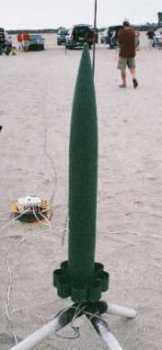
Brief:
OctoPod was created to test how well an 8-tube HPR tubefin would perform compared to the 5-tube, 6-tube and 7-tube tubefin rockets I have described previously on EMRR. Everybody at the field kept telling me "so if you say in your articles that 6 is better than 5, and 7 is better than 6, why haven't you tested an 8-tuber?". OK, I finally did. The results were mixed - and disappointing.
Bottom Line: Not worth the extra fuss required; it wobbles: 8 tube fins, each exactly half the diameter of the body tube, appear not to give adequate dynamic stability to what is otherwise a very efficient lay-out (low Cd) at high speed. Fun to fly, and the spiral smoke trail amuses spectators - but not what I was after. 8-tube OctoPod is really a horse of a different color, not like any other tubefin design I have flown, and I have flow LOTS.
Construction:
The body tube consists of 20" of LOC 4" tubing, and the tube fins were each 2" long and cut from 2" heavy wall postal mailing tube. By gluing a 1/8"x1/8" spruce spacer to each tube fin, proper spacing around the body tube was achieved. The first tube fin (no spacer attached) is glued to the body tube while aligned on a flat surface, and the subsequent tubes are then attached with the spacer glued flush to its neighbor.
A gap remained after the 8th tube fin was in place, and this was filled with an additional 1/8" square spacer. A 1/8" ply 29mm size 4" centering ring was glued 1" from each end of a 12" piece of LOC 29mm motortube to create the motor mount assembly. An 18" loop of heavy nylon para cord was passed through 2 holes drilled in the upper ring and knotted, the recovery system (30" nylon parachute with 8' of para cord and a 9" Nomex) was later anchored to this.
The motor mount assembly was glued into place in the body tube in the usual way. The nose cone was a discontinued 4" plastic model from North Coast Rocketry; a 4" LOC cone would have sufficed. The base and all but 2" of the hip was sawed off the cone, and a 3/8" dowel rod length was glued in just above the hip to serve as the anchor to the parachute-shock cord (see the article in EMRR on "TeaBird 4.0" for details.
During flight testing, a 4" weighted cone salvaged from a crashed Performance Rocketry Little John was substituted (the weight of 37 oz. and length of 41" given above is with the one pound "Little John" cone). The launch lugs were 2 x 1 1/4" pieces of 5/16" brass tube attached at the midpoint of the body tube and just above the tubefincan, both aligned with one of the triangular spaces between tube fins. Finish was with Tamiya rattle-can olive green. The Little John cone was painted Tamiya flat white.
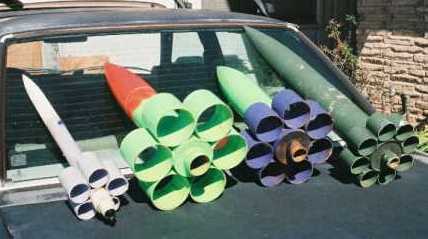
One thing I should point out here is the construction quirk associated with OctoPod: there aren't a lot of choices for making 8-tube tubefins. The geometry of 7-tubers is simply going down one size to craft proper fitting tube fins: e.g., 38mm tube fins for a 54mm tubefin, 54mm tube fins for a 3" tubefin rocket, 3" tube fins for a 4" rocket, 4" tubes for a 5.5" tubefin, 5.5" tube fins for a 7.5" rocket. The math doesn't work out so well for an 8-tube tubefin, at least for HPR size, since the required tube fin size is about 50% of the body tube size. Besides the Octopod set-up, 38mm tubes should work on a 3" body tube, and 3" tubefins could work with the 6" PML tubing and cone. That's about it.
Finishing:
I liked being able to use low-cost 2" postal mailing tubes for OctoPod, they are low-cost and strong. I also used them to built my 5-tube "El Cheapo Certo", described earlier on EMRR
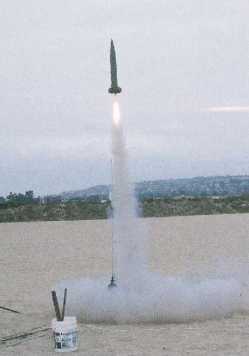 Flight:
Flight:
The first flights of OctoPod were on G77-4 Redline and G78-4 Green Mojave motors, using a taped-on external parasite pod and Perfectflite Alt15k to record performance. The boosts were straight enough, but the smoke track was clearly spiral - a "wacky wiggler".
Did I not align the tube fins properly? Was CG too far aft? I carefully checked this out, and everything seemed in order.
I tried more and then less power - an H128-6 (photo) and an F50-6. F50 boost was straight, but Octopod visibly wobbled on the H128, and it wasn't just a spiral smoke trail. Still, drag coefficient (Cd) on the H128 worked out to an impressive 0.80 at 320 mph from the 1040' climb. I then moved up to an Aerotech H180-6, and directional stability went from bad to worse, the wobbling was fairly violent, and it was clear that this was all the power and speed OctoPod could take. Cd on the H180 was 0.84 at 347 mph.
I decided to try moving the CG forward, thinking that with these small tube fins, maybe CP wasn't as extremely far aft as it is with 5, 6 or 7 tube fins. To do this, I simply swapped the NCR plastic cone with a heavy, weighted 4" fiberglass cone I rescued from a crashed Performance Rockets Little John. This increased the weight of Octopod from 630 gm. to 1050 gm., and moved the CG to the midpoint of the airframe - way nose heavy.
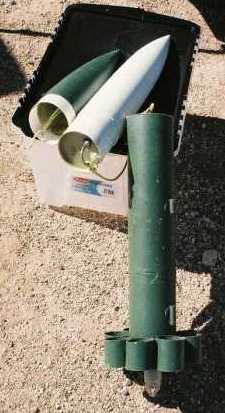

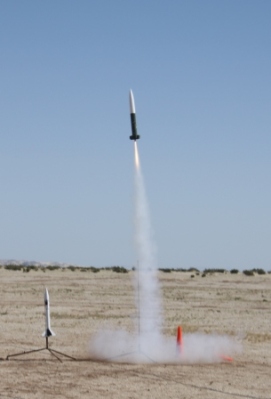 When I resumed flight testing, the flight behavior substantially mellowed out, but the spiral track was not entirely eliminated. The "new improved" OctoPod still wobbled slightly on G78 power, and with Pro29 H255-7 and I204-8 power, the rocket boosted perfectly straight but began to wobble(see launch photo) - slight spiral smoke trail only after burn-out.
When I resumed flight testing, the flight behavior substantially mellowed out, but the spiral track was not entirely eliminated. The "new improved" OctoPod still wobbled slightly on G78 power, and with Pro29 H255-7 and I204-8 power, the rocket boosted perfectly straight but began to wobble(see launch photo) - slight spiral smoke trail only after burn-out.
On the letter motor, Octopod achieved a very low Cd=0.70 at 416 mph from the 1763' climb, which is as good as I see on the best tubefin designs at this speed. On a Pro29 H163-7 Red Lightning, OctoPod (finally!) rewarded me with a perfectly straight boost with no hint of spiral track, to 952', for an imputed Cd=0.77 at 240 mph. The results of all the test flights are summarized in the graph of Cd vs. speed obtained, comparing the two different nose cones (and CG's) with the performance of the 4" 6-tube Tea-Bird 4.0 (upper graph) from an earlier EMRR article.
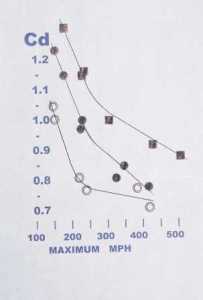 You can see that the 8-tube arrangement is clearly superior drag-wise to the 6-tube design with all motors, and if you look at the "Dwarf King 4.0" article in EMRR, the heavy nose-cone OctoPod (bottom graph) even compares favorably with the 7-tube arrangement.
You can see that the 8-tube arrangement is clearly superior drag-wise to the 6-tube design with all motors, and if you look at the "Dwarf King 4.0" article in EMRR, the heavy nose-cone OctoPod (bottom graph) even compares favorably with the 7-tube arrangement.
Without the wobble problem, OctoPod would be getting even better numbers. But that's the point - OctoPod DOES wobble. The low drag is achieved at the expense of dynamic stability, and even that requires a ton of nose weight. This is not what you like to see.
Tubefin rockets typically require Zero nose ballast, even stubbies with heavy motors. So OctoPod is not a typical tubefin rocket. Its kind of fun to fly, but I don't think I'll build another 8-tuber. Seven tubefins is best.
 Recovery:
Recovery:
Octopod in my opinion represents "the outside of the envelope" for tube fins. Low drag, but unfavorable flight performance. You see the same thing with modern aircraft and race cars - get them too slippery and the handling suffers. One attractive feature is that the small diameter tube fins make the rocket look "normal" from the side while launching. You can't even tell its a tube fin (photo), looks like a scale Little John in profile on the I204!
Summary:
PRO: Fast and low-cost scratch build, with the postal mailing tube fins. Smaller-size tubefins improve the appearance of an 8-tuber.
CON: It wobbles, may be short on dynamic stability. Don't dare fly it on more than baby "I"-power. Eight tube fins give limited chouces for scaling up or down. Needs a ton of nose weight to fly right, unlike all other tubefins.
Sponsored Ads
 |
 |











